|
Würzburg, Part 2
Würzburg During the War
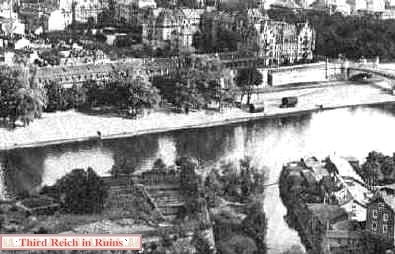
|
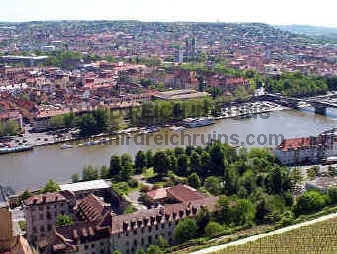
|
Some
of the Würzburg wartime industry centered on manufacture of parts for U-boot submarines.
This industry was located along the Main River, and the buildings were substantially
destroyed during the 1945 bombings. (Stadtarchiv Würzburg) |

|

|
On the
left is an RAF reconnaissance photo, taken after the bombing on 16 March 1945. The
burned-out shell of the Residenz can be seen near the lower left. Recovered phosphorus
(incendiary) bombs that did not explode are displayed in the "Gedenkraum (Memorial
Room) 16.März 1945" in the Rathaus. (Royal Air Force photo / Stadtarchiv
Würzburg) |

|

|
Other
bombs in the display include 250 to 500-pound high explosive types, and a huge British
HC 4000-pound "Cookie" block-buster bomb. |

|

|
These
photos from the United States Strategic Bombing Survey show (left) the beginning of an 8th
Air Force attack on 23 February 1945 - the bombs are not yet hitting, but the smoke
markers have been dropped on the target of the rail yards (white trails). The
Residenz is in the right-center of the photo, with the Main River at the bottom. On
the
right, Würzburg as it was seen in April 1945. The severely-damaged St. Kilian's Cathedral
is in the center. (National Archives, RG 342-FH, 3A22668, 3A22667) |

|

|
The
Würzburg Hauptbahnhof (main train station) burns after a February 1945 bombing
attack. The train station was later rebuilt, but in a more modern style. (Stadtarchiv
Würzburg) |

Façade of the
Würzburg Hauptbahnhof as seen in June 1945, after the
destruction. (author's collection)

|

|
Soldiers
of the U.S. 42nd Infantry Division cleared the rubble of Würzburg on 3-4 April 1945.
These soldiers are moving out of the Dominikanerplatz on the narrow Innerer Graben street.
Compare the street lamp seen in the distance in the period photo, just above the GIs'
heads in the center, to those seen in the right foreground and the center distance in the
modern view. (U.S. Army photo / Stadtarchiv Würzburg) Click here to visit a page concerning the
fighting west of Würzburg, during the American advance from the Rhein. |

|

|
This GI has found a
disabled German Jadgpz.38 tank destroyer "Hetzer" at the corner of Sanderring
and Münzstraße. (Dr. Hans Oppelt, ed., "Würzburger Chronik," Würzburg,
Verlag Ferdinand Schöningh, 1947 (published under American Military Government
Information Control) |

|

|
GIs
drive their jeep down Sanderring, toward the Hetzer seen in the photo
above. The original ornate building on the corner has been replaced, but
the same courthouse building can still be seen in the distance. (U.S.
Army photo) |

|

|
This photo, taken by U.S. Army
soldier Jerry Pinkowski, shows the burned out Würzburg Residenz. (courtesy
Scott Pinkowski, Lost
Images of World War II - visit Scott's page for other then-and-now views of
war torn Würzburg) |
Same view today. The magnificent
18th century rococo palace of the Prince-Bishops of Würzburg has been wonderfully
restored. (see also below) |

The Residenz in July 1945, as seen
through a GI's camera lens. (author's collection)

|

|
The
Baroque mansion "Falkenhaus" is another example of the wonderful post-war
rebuilding of Würzburg. (Stadtarchiv Würzburg) |

|

|
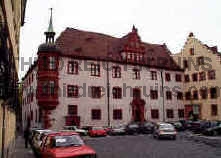
|
The Baroque Bishops
Palace (Hof Conti) was badly damaged during the bombing, and completely restored. (Stadtarchiv
Würzburg) |

|

|
The
Gestapo headquarters building in Würzburg was located at Ludwigstraße 2. The building
was badly damaged by bombs, and was not rebuilt in the same style. (Stadtarchiv
Würzburg) |

|

|
A GI
guards the famous Alte Main Brücke (Old Main River Bridge) and the rubble of the
Würzburg Altstadt (old city). His guard post is at the base of the statue of
Saint Colonatus, one of 12 statues on the bridge (a headless Pat. Franconia appears at the
left). The domeless spire of the Neubaukirche church, nearly obscured by post-war
construction in the modern view, appears in the right distance. (U.S. Army
photo) |

|

|

|
| Three views of the Alte
Main Brücke and the Würzburg Altstadt (old city) - before the war (left),
after the U.S. occupation in 1945 (center), and today (right). These photos were all taken
from the outer works of the Marienberg Fortress. (left - Dr. Hans Oppelt, ed.,
"Würzburger Chronik," Würzburg, Verlag Ferdinand Schöningh, 1947 (published
under American Military Government Information Control); center - Stadtarchiv Würzburg) |

|
Soldiers of the U.S. 42nd
Infantry Division (the "Rainbow" Division), which had captured Würzburg on 4
April 1945, cross a temporary iron trestle erected on the Löwenbrücke bridge to
span a portion that was blown up by retreating Germans. Not visible at this scale, but
seen on the original photo above, is painted graffiti in white letters on the lower
portion of the Marienberg Fortress, closest to the river - "Heil Hitler!"
In the second photo below, men of the 431st Anti-Aircraft Battalion guard the river
crossings with quad-50 caliber machineguns. The "Heil Hitler!" on the Marienberg
Fortress has been replaced with "42nd RAINBOW INFANTRY DIVISION." (42nd
"Rainbow" Infantry Division. Baton Rouge, LA, Army & Navy Publishing Co.,
1946) |

|

|
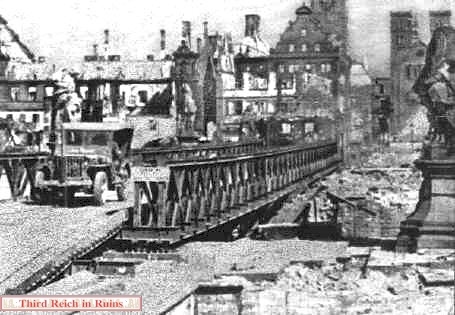
This photo shows a closer view of the iron span
put in place by U.S. Army engineers,
to replace part of the Alte Main Brücke that had been blown by the Nazis during
their retreat. (U.S. Army)
|

|

|
| German
POWs march to the rear, guarded by the crew of a Sherman tank. The blown
span of the Löwenbrücke can be seen in the background, with
the Marienberg Fortress on the hill behind. The original parts of the
bridge still show several marks from projectiles fired in 1945. (U.S. Army photo) |
|

|

|
| The Löwenbrücke
(now called the Ludwigsbrücke) was named for the bronze lion
statues at each corner. Some of these also show the remains of war
damage - the lion seen from behind, with several nicks and holes from
bullets, is the one on the left in the first photo. (Thanks to
Randy Waldron for pointing this out to me!) |

The bombed and burned Festung Marienberg
in July 1945. (author's collection)
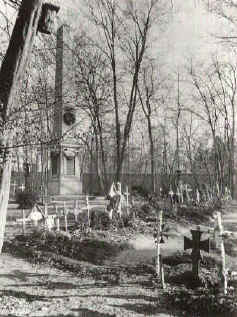
|

|
| Most of the bombing
casualties were buried in mass graves in the city cemetery, near the military monument.
The 1945 wooden markers were eventually replaced by a single large memorial monument, seen
in the photo below. This memorial was by Würzburg sculptor Fried Heuler,
who also designed the Würzburg war
memorial. (These photos were taken on the 60 anniversary of the
bombing of Würzburg, 16 March 2005.) (Stadtarchiv Würzburg) |

|

|
This
sculpture "Death by Bombing" in front of the St. Johannis
Church honors the memory of the bombing victims.
The work was a gift to Würzburg
from the Russian artist Vadim Sigur. |

|

|
This 1946 view of the Marktplatz shows the rebuilding in progress. The fallen rubble has
been cleared from the streets, and is being hauled away by a Trommelzug (rubble
train), a common sight in most German postwar cities. (Stadtarchiv Würzburg) |
-

|

|
Under
new management - a Bundeswehr parade in the Residenzplatz in
1965. Most of the Residenz exterior had been rebuilt by that time, but a large pile of
rubble can still be seen in the courtyard, behind the Franconia fountain. (Compare to the
1945 photo by Jerry Pinkowski, above.) (Stadtarchiv Würzburg) |

|

|
One of
the M-47 tanks "on guard" at the Residenzplatz. The photo in the first group
above was shot from the balcony of the bank building in the background of these
photos. (Stadtarchiv Würzburg) |
Links
Bloody Battle for Wuerzburg -- http://www.military.com/Content/MoreContent?file=PRwurzburg
Würzburg Digital - page about the US Army in
Würzburg -- http://www.wuerzburg-photos.de/barracks.html
National Socialist Buildings in Würzburg -
guide with maps and photos (in German) --
http://www.fkg-wuerzburg.de/schule/faecher/geschichte/facharb/kiesel/data/index.htm
Click here
for a MapQuest map link to Würzburg.
 Back to the Third Reich in Ruins homepage
Back to the Third Reich in Ruins homepage
|
